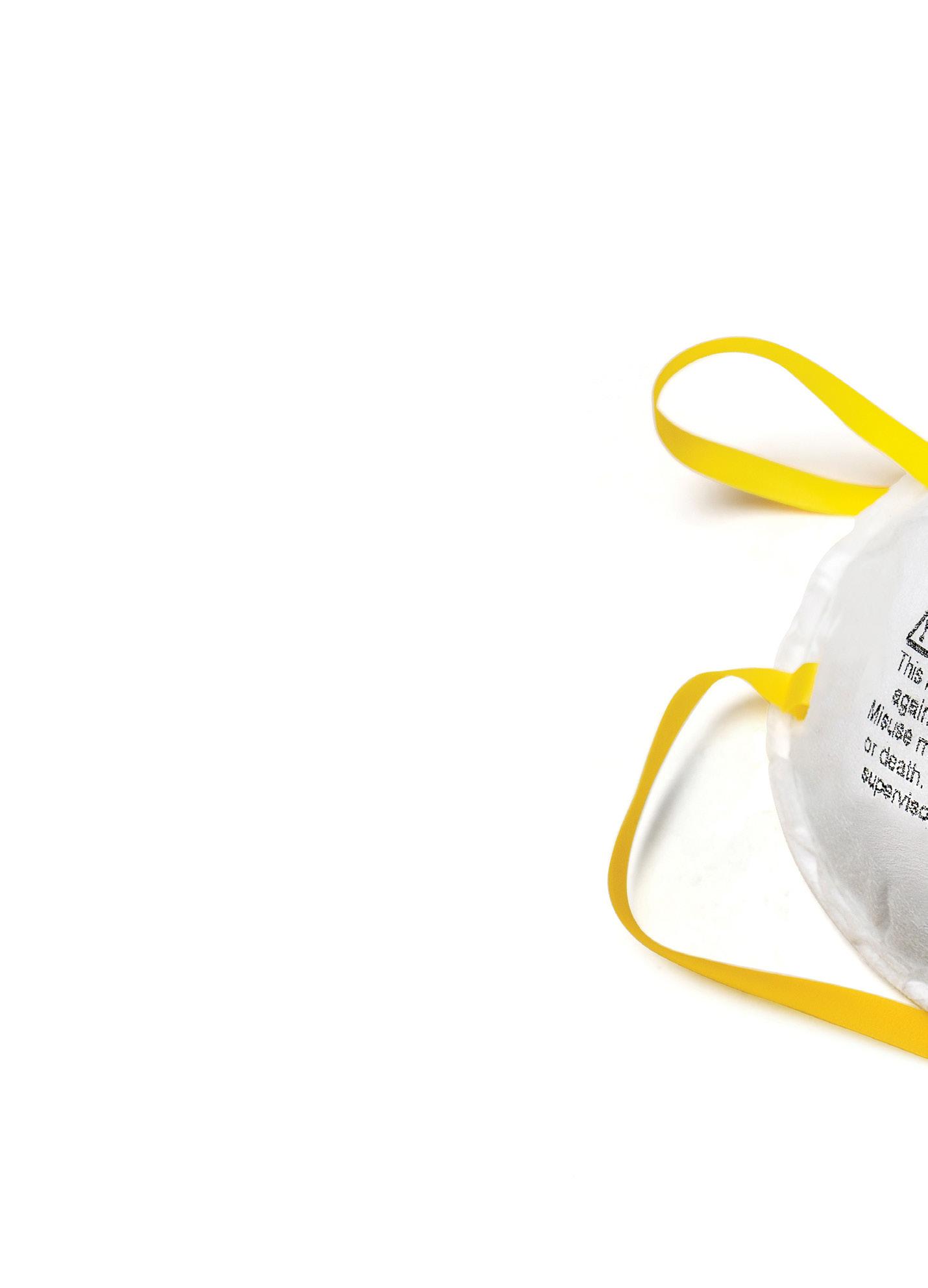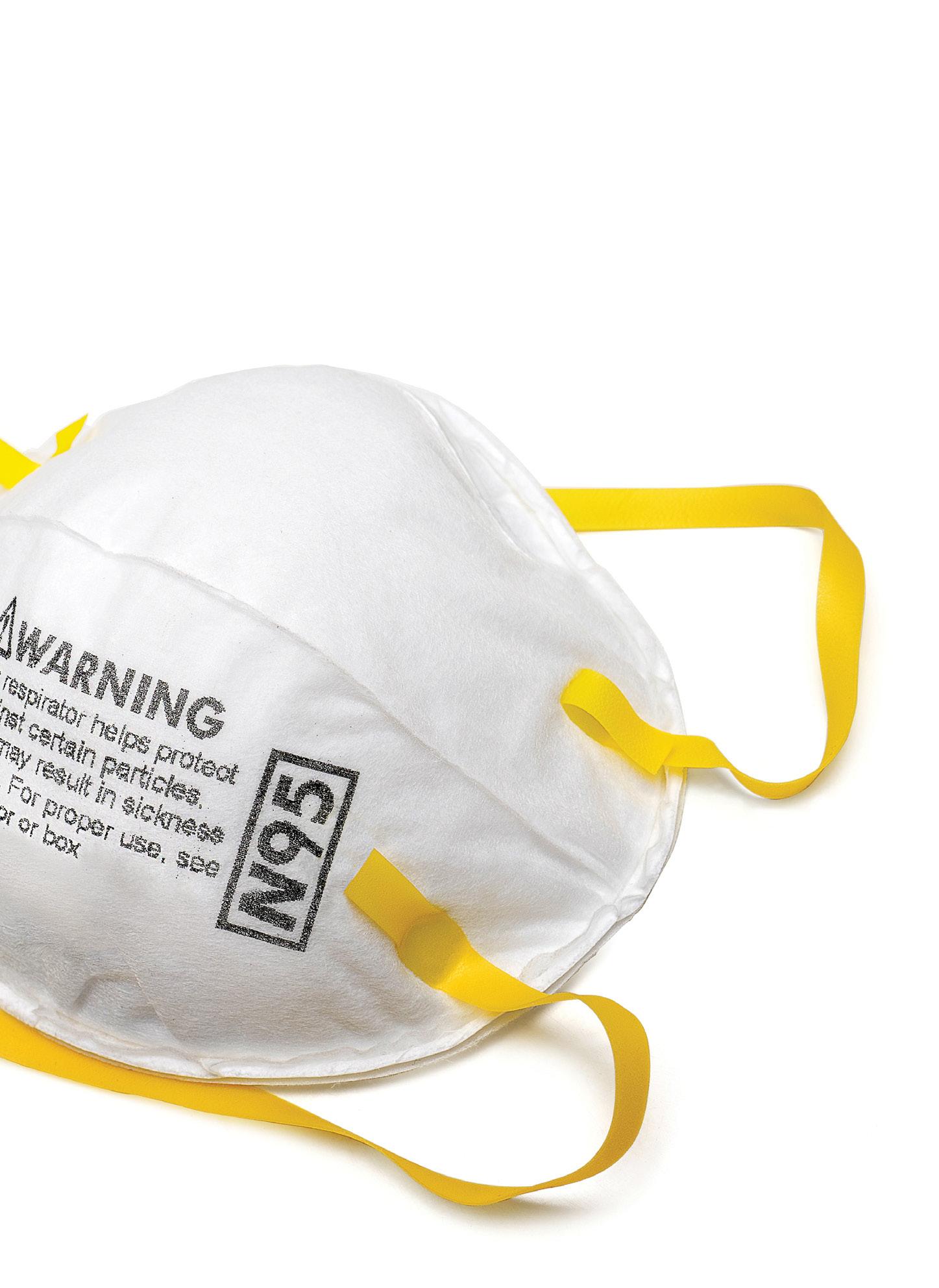
14 minute read
COVID-19 and Our Industry. Published April 2020
COVID-19 and Our Industry

By Kim Fernandez
What the pandemic means for parking and mobility operations, and what professionals are doing to keep things moving.
IT’S DIFFICULT TO THINK THAT WHEN A MYSTERIOUS NEW VIRUS infected 41 people in Wuhan, China, last December, anyone could have foreseen the coming global effect. COVID-19 has dominated the news and many businesses—including parking and mobility—during the first quarter of 2020, and doesn’t show many signs of slowing down anytime soon.
First called similar to the flu, COVID-19 causes headaches, fever, body aches and chills, digestive issues, and respiratory complications that can grow into a fatal form of viral pneumonia. At press time, vaccine and treatment trials had begun but overwhelmed hospitals and medical professionals could only treat symptoms and hope for the best. Highly


contagious, the virus forced virtual shutdowns of businesses, schools, and cities around the world. And those closures have had massive effects on parking and mobility, from empty garages and lots to micro-mobility service disruptions to the well-being of staff members—and all of that has rocked the industry’s economy.
Staffing and People
Starting in mid-March, companies in the U.S. were strongly encouraged to have employees work from home whenever possible; stay-at-home orders in many cities strengthened the ask. Parking and mobility operations shifted where they could, but it wasn’t possible for everyone. Mike Estey, manager of parking programs with the City of Seattle, Wash., says most of his staff began working from home fairly quickly, but it wasn’t possible for everyone. Despite lowered demand for parking, frontline staff largely can’t work from home, and that’s created its own challenge. “The field side is more difficult,” he says. “The office staff is working from home but the field staff can’t always do that.
So the field staff feels like there are haves and have-nots, and they are the have-nots.” He works on constantly communicating with them and offering whatever support he can to dissipate that issue.
Hal King, CAPP, parking administrator with the City of
Hollywood, Fla., says some issues come down to essential vs. non-essential functions and employees, especially when states decide who can and can’t move around or go to work based on those labels.
“We normally deal with hurricanes and everyone gets the essential tag put on them,” he says. “Now, we can’t go back and say those people are non-essential.” His downtown garages were about 60 percent full at press time, largely by residents of the city, but beach garages were empty.
“We have to have staff on standby,” he says. “And what do you do with those people if you just send them home? I’d prefer to keep people on the payroll and not have them burn up sick leave or vacation time or anything else for a situation that’s totally out of their control.”
Others have found ways for frontline people to keep their jobs doing different things. “We have about 150 officers a day on the street,” says Shawn McCormick, parking enforcement director, San Francisco Municipal Transportation Agency (SFMTA). Those people are doing enforcement and working on curb management to ensure employees aren’t parking in front of businesses all day and keeping pick-up customers out of valuable parking spots. In an effort to keep people on the payroll and do good, McCormick says some officers began patrolling neighborhoods, offering a sense of presence and letting people know the city is still around.
“Some of our officers are taking on other assignments,” he says. “They’re stuffing bags with masks and gloves for hospitals, they’re cleaning buses, and they’re doing other things.”
In areas where parking enforcement has continued,
Updated on March 19, 2020
The EEOC enforces workplace anti-discrimination laws including the Americans with Disabilities Act (ADA) and the Rehabilitation Act, including the requirement for reasonable accommodation and rules about medical examinations and inquiries. The ADA and Rehabilitation Act rules continue to apply, but they do not interfere with or prevent employers from following the guidelines and suggestions made by the CDC or state/local public health authorities about steps employers should take regarding COVID-19.
Employers should remember that guidance from public health authorities is likely to change as the COVID-19 pandemic evolves. Therefore, employers should continue to follow the most current information on maintaining workplace safety.
The EEOC has provided guidance (a publication entitled Pandemic Preparedness in the Workplace and the Americans With Disabilities Act [PDF version]), consistent with these workplace protections and rules, that can help employers implement strategies to navigate the impact of COVID-19 in the workplace. This pandemic publication, which was written during the prior H1N1 outbreak, is still relevant today and identifies established ADA and Rehabilitation Act principles to answer questions frequently asked about the workplace during a pandemic. It has been updated as of March 19, 2020 to address examples and information regarding COVID-19; the new information appears in bold. The World Health Organization (WHO) has declared COVID-19 to be an international pandemic. The EEOC pandemic publication includes a separate section that answers common employer questions about what to do after a pandemic has been declared. Applying these principles to the COVID-19 pandemic, the following may be useful:
• How much information may an employer request from an employee who calls in sick, in order to protect the rest of its workforce during the COVID-19 pandemic? –During a pandemic, ADA-covered employers may ask such employees if they are experiencing symptoms of the pandemic virus. For COVID-19, these include symptoms such as fever, chills, cough, shortness of breath, or sore throat. Employers must maintain all information about employee illness as a confidential medical record in compliance with the
ADA.
• When may an ADA-covered employer take the body temperature of employees during the COVID-19 pandemic? –Generally, measuring an employee’s body temperature is a medical examination. Because the CDC and state/local health authorities have
staff remains on the street. “We’ve been working very hard at trying to stay ahead with the message of what we’re doing as an essential means of maintaining traffic flow,” says Scot Reinmann, section chief, parking operations, Montgomery County, Md., Department of Transportation. “We’re examining it constantly.” His office has made parking in two garages free for residents who don’t normally need off-street parking or who want to store vehicles until the crisis is over.
“If you’re still letting people park in your facility, it’s essential that you keep it safe,” he says. “I’m seeing most of our functions as essential, and we’re trying to be flexible with employees who have childcare issues. We are providing some level of safety and service as long as we’re available to be open.”
Operations and Revenue
Not everyone can keep their people working because demand is down significantly, and that has real affects on revenue and budgets.
“Parking revenue and utilization is down anywhere between 40 and 70 percent per facility,” says Aurora Perkins, parking administrator, City of San Antonio, Texas. “The highest-impact facilities are those surrounding convention center operations, which have canceled all conventions and meetings until the first week of April [at press time].”
Enforcement is ongoing, she says, but officers have been given expanded areas to review. San Antonio has actually seen a bigger need for enforcement pertaining to parking violations and solid waste services. “More
acknowledged community spread of COVID-19 and issued attendant precautions, employers may measure employees’ body temperature. However, employers should be aware that some people with COVID-19 do not have a fever.
• Does the ADA allow employers to require employees to stay home if they have symptoms of the COVID-19? –Yes. The CDC states that employees who become ill with symptoms of COVID-19 should leave the workplace. The
ADA does not interfere with employers following this advice.
• When employees return to work, does the ADA allow employers to require doctors’ notes certifying their fitness for duty? –Yes. Such inquiries are permitted under the ADA either because they would not be disability-related or, if the pandemic influenza were truly severe, they would be justified under the ADA standards for disability-related inquiries of employees. As a practical matter, however, doctors and other health care professionals may be too busy during and immediately after a pandemic outbreak to provide fitness-for-duty documentation. Therefore, new approaches may be necessary, such as reliance on local clinics to provide a form, a stamp, or an e-mail to certify that an individual does not have the pandemic virus. • If an employer is hiring, may it screen applicants for symptoms of COVID-19? –Yes. An employer may screen job applicants for symptoms of COVID-19 after making a conditional job offer, as long as it does so for all entering employees in the same type of job. This ADA rule applies whether or not the applicant has a disability.
• May an employer take an applicant’s temperature as part of a post-offer, pre-employment medical exam? –Yes. Any medical exams are permitted after an employer has made a conditional offer of employment.
However, employers should be aware that some people with COVID-19 do not have a fever.
• May an employer delay the start date of an applicant who has COVID-19 or symptoms associated with it? –Yes. According to current CDC guidance, an individual who has COVID-19 or symptoms associated with it should not be in the workplace.
• May an employer withdraw a job offer when it needs the applicant to start immediately but the individual has
COVID-19 or symptoms of it? –Based on current CDC guidance, this individual cannot safely enter the workplace, and therefore the employer may withdraw the job offer. Source: EEOC.gov
families are home with more vehicles on the street and an increase in residential trash output,” she says.
Benito Pérez, AICP, CTP, curbside management operations planning manager at the District of Columbia Department of Transportation, says his department’s role has grown as well, “between outreach to reiterate CDC (Centers for Disease Control) guidance, move critical and business services online, and also continue to operate the transportation network for those who continue to rely on it—vulnerable populations, essential/emergency responders, and employees.”
“The District Department of Transportation continues to operate and maintain our curbside as-is, with some exceptions such as lifting rush-hour restriction enforcement. We are contemplating how we can repurpose our curbside to facilitate enhanced pick-up/drop-off activity to support our food service and restaurant, pharmacy, and grocery businesses as those businesses transition to takeout/delivery models. That means contemplating revamping our existing Pick-up/Drop-off (PUDO) Zone program, whether temporarily or permanently.”
That’s a common theme in cities where parking organizations are called upon to help support businesses trying to survive the pandemic. Many have launched pick-up parking on the curb, offering customers a certain amount of free parking so they can patronize restaurants and stores safely. For many, it’s leading to other thoughts for a different future.
“As we continue to rethink curbside management in light of COVID-19, we are thinking not only in the immediate term and needs, but the ramifications of curbside in a more digitized future that will emerge after this public health emergency,” says Pérez. “Online food delivery (from restaurants and grocery stores) were nascent and starting to grow before this emergency. We have to start thinking now that such business activity will start to become a major part of our future and has huge ramifications on how we manage our curbside.”
For now, operations have shifted drastically. Ted Graf, director of parking, San Francisco Municipal Transportation Agency, says demand is down, which has led to agency consolidation.
“As a consolidated transportation agency—that is, parking, traffic engineering, and transit are all under one roof and policy dictates parking revenues are to support transit—the impacts of COVID19 are pervasive,” he says. “Parking impacts are being measured by both revenue and utilization. Garage visits and revenue decreased by about 50 percent for the time period of March 1 to 19, and narrowing the time window to March 17 to 19 shows a reduction of 90+ percent; this spike is result of the city partially closing 15 of its 20 garages effective on March 18.”
“In parallel, on-street parking revenue decreased by about 70 percent as compared to March 2019,” he says. “Beyond revenue impacts, the agency expedited consideration of temporary changes to many parking policies (rates, time limits, enforcement, etc.) to best address the shift in demand during this crisis period.”
His staff is working to keep figures up to date and assess the total impact.
“With respect to parking regulations and enforcement, it was decided to cease enforcement for several regulations such as permit parking, general time limits, and street cleaning, but enforcement would continue for critical points of access—fire hydrants as well as other conditions for safety,” he says. “Parking enforcement is also being maintained for meters because meters are in locations where turnover is necessary for essential services including grocery stores, medical facilities ,and banks.” For now, meters have been reduced to base rates: $.50 per hour for vehicle spaces and $.10 per hour for motorcycles.
Empty Campuses
For university parking offices, COVID-19 has been a complete game-changer. Students and faculty have largely been sent home, leaving questions about staffing, enforcement, and the question they hear over and over—what about refunds?
Rodney Gomez, CAPP, executive director of parking & transportation at University of Texas Rio Grande Valley, says, “The biggest impact has been the loss of student, faculty, and visitor activity on our campuses. We have had to rethink our enforcement protocols as well as the level of service provided via our transit routes. We have had to be very adaptive to meet evolving needs while still adhering to safety protocols.”
Gomez says his university administration has been “on top of things from the beginning,” which eases some of the crunch. His office is focused on safety, with continuous monitoring and adjustments to keep customer service high.
“It’s a tough time for everyone and it’s important to keep morale up,” he says. “The future is very uncertain. We engage our staff as much as possible in our decisions, share knowledge as soon as we can, and encourage everyone to share their thoughts and feelings. It’s very easy to lose sight of the importance of community during this time.”
Other universities have similar things to share. Kevin Rowald, CAPP, director of parking and transportation at the University of Kansas Medical Center, says his blended world offers unique challenges, especially now.
“The leadership teams of the health system and university are communicating numerous times per day via numerous media avenues to adjust and react as necessary,” he says. “Our emergency management department is effectively executing and adjusting our established plans daily to accommodate new situations as the present themselves.”
“It has taken the entire campus working in synergy to address this challenge. Critical planning had taken place well in advance and then the entire team has shown a unique ability to be execute the plan while being nimble enough to adjust efficiently as the situation has changed. I am grateful to be a part of a great unified team,” he continues.
Aaron Quisenberry, associate director, student involvement and leadership center, University of Kansas, says the challenges are numerous, from bus route changes to working with the city to having all staff working from home. “It seems like I’ve got a dozen webinars or Zoom calls a day, trying to figure out what level of service we’re offering,” he says. “It seems like I’m busier than normal and there are so many different dynamics at play.”
He says communication is a priority, both with his staff and others across campus, up to and including guidance on what to do when someone shows COVID-19 symptoms.
Many participants of an IPMI online Shoptalk for university and campuses said refunds are a hot issue— when or whether to offer them and then how. An informal poll during the event showed slightly less than half of participants were actively offering refunds to students, and a popular sentiment was that faculty/staff payroll deductions for parking had simply stopped. Those were not true on campuses that still housed students, largely because they lived overseas and couldn’t go home. And a big concern was raised by Ross Allanson, CAPP, University of Minnesota: “What do we do with employees who are supposed to work from home but can’t do their jobs that way?” ◆
KIM FERNANDEZ is IPMI’s director of publications and editor of Parking & Mobility. She can be reached at fernandez@parkingmobility.org.
Resources
At press time, IPMI had hosted four online Shoptalks for COVID-19 conversation and sharing. More events are planned for the future—watch parking-mobility.org for dates and registration.
Conversation on Forum (forum.parking-mobility. org) is flowing, with ideas, challenges, and collaboration happening daily. Forum is open to all IPMI members and their staffs and shared documents become part of the permanent, searchable library. To participate, sign in with your parking-mobility.org credentials (resetting those is easy). For more information on using Forum, email fernandez@parking-mobility.org.
For up-to-date information on COVID-19, reference the World Health Organization (who.int) or U.S. Centers for Disease Control (cdc.gov). Information from the Equal Employment Opportunity Commission and a fact sheet from the U.S. Department of Labor are included in boxes with this article.







